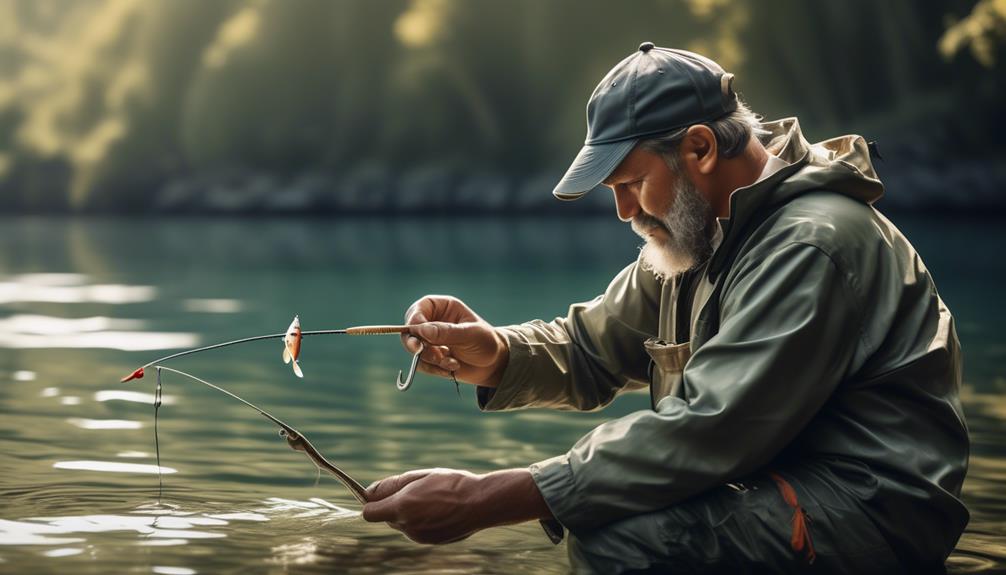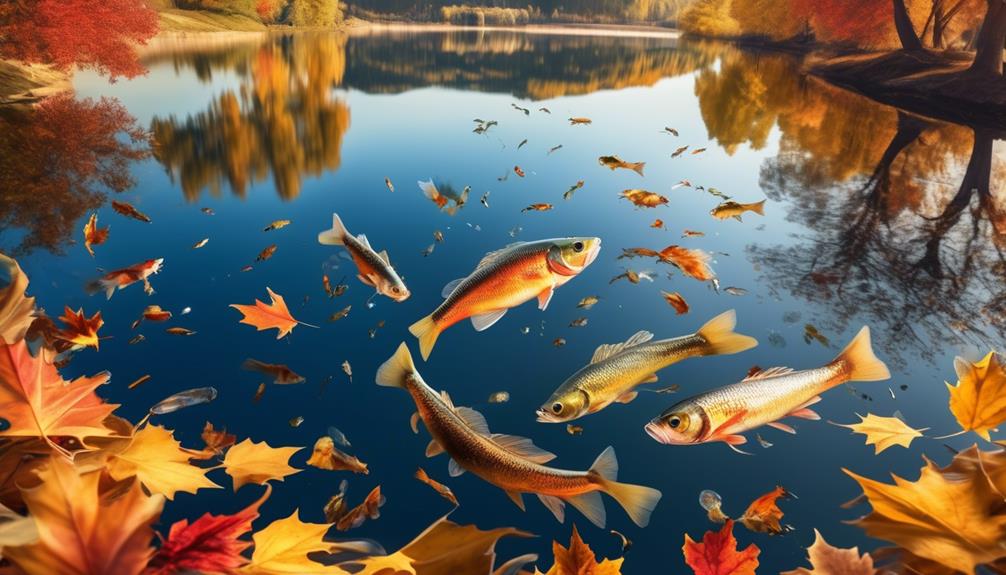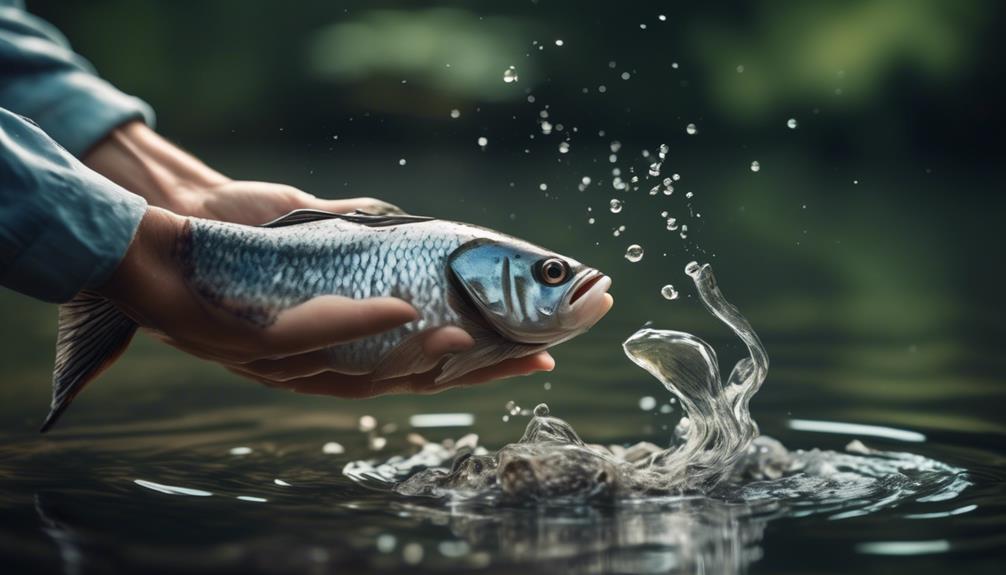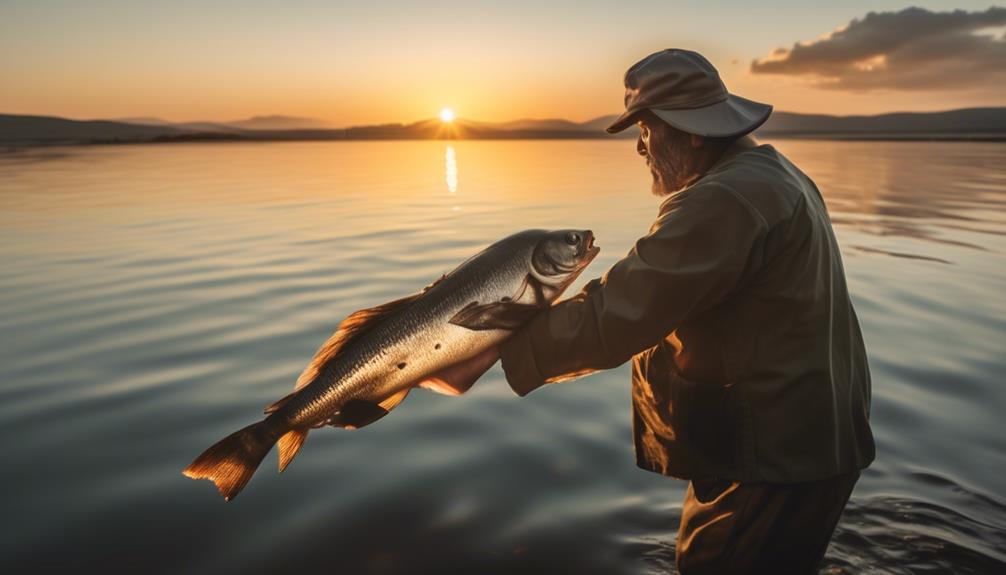So you've reeled in that impressive catch, but now comes the crucial decision of what to do next. As an angler, it's essential to consider the impact of catch-and-release practices on the fish population and ecosystem.
Ethical catch-and-release angling is not just about tossing the fish back into the water and hoping for the best; it involves a set of principles and practices that prioritize the well-being of the fish and the sustainability of the sport.
By understanding and implementing these five key principles, you can ensure that your angling activities contribute to the long-term health of fish populations and their habitats.
Understanding Fish Stress
To ensure the well-being of the fish you catch and release, it's crucial to understand the factors that contribute to fish stress during the angling process. Fish, like all creatures, exhibit behavior that can indicate stress. Understanding fish behavior and stress indicators is essential for ethical catch-and-release angling.
Fish behavior can provide valuable insights into their well-being. When stressed, fish may exhibit erratic movement, such as swimming frantically or erratically. They might also show changes in their feeding patterns and become less responsive to bait. Additionally, stressed fish may display altered breathing patterns, often breathing rapidly at the water's surface. Recognizing these behavioral cues is vital for anglers aiming to minimize stress during catch-and-release.
Stress indicators in fish aren't only behavioral but also physiological. Elevated levels of cortisol, known as the stress hormone, can be found in stressed fish. Furthermore, physiological stress can lead to compromised immune function, making fish more susceptible to diseases. Understanding these indicators can help anglers assess the well-being of the fish they catch.
Proper Handling Techniques
Handling the fish with care and attention is paramount to minimizing stress and ensuring a successful catch-and-release experience. Proper fish handling techniques play a crucial role in stress management, which directly impacts the fish's survival after being released.
When you land a fish, avoid causing unnecessary harm by wetting your hands before handling it. Dry hands can remove the fish's protective mucus layer, making it more susceptible to infection. Additionally, use barbless hooks if possible, as they're much easier to remove and cause less damage to the fish.
When handling the fish, support its body weight properly, especially if it's a larger species. Avoid squeezing the fish or putting excessive pressure on its vital organs. Be mindful of the fish's fins and gills, as these are delicate areas that can be easily injured.
If you need to unhook the fish, do it quickly and efficiently, minimizing the time it spends out of the water. Finally, when releasing the fish, hold it in the water facing into the current, allowing it to regain its strength before swimming away.
Selecting the Right Gear
Gear selection plays a crucial role in ethical catch-and-release angling. Here are some key considerations to help you make the right choices:
- Matching the Gear to the Fish: Ensure that the gear you select is appropriate for the species you intend to catch. Different fish require different tackle and equipment. For instance, using lightweight gear when targeting large, powerful fish can result in prolonged fights, causing excessive exhaustion to the fish.
- Quality and Durability: Invest in high-quality gear that's durable and reliable. Quality gear not only enhances your angling experience but also minimizes the risk of equipment failure, which can lead to unintended harm to the fish.
- Equipment Maintenance: Regularly maintain and inspect your fishing gear. Check for any signs of wear and tear, and replace any damaged components. Properly maintaining your gear ensures that it functions as intended, reducing the likelihood of equipment malfunctions during the catch-and-release process.
Selecting the right gear not only contributes to the success of catch-and-release angling but also reflects your commitment to the ethical treatment of fish. By considering the specific needs of the fish species, investing in quality gear, and maintaining your equipment, you can contribute to the sustainability of fish populations while enjoying a fulfilling angling experience.
Conservation-Minded Practices
Selecting the right gear not only contributes to the success of catch-and-release angling but also reflects your commitment to implementing conservation-minded practices for sustainable fishing. Understanding fish behavior is crucial for effective catch-and-release angling. When handling fish, it's important to minimize the time they spend out of water and handle them with wet hands to protect their delicate mucous layer. Additionally, using barbless hooks can facilitate easier hook removal, reducing potential harm to the fish. By paying attention to fish behavior and making conscious decisions about gear and handling, you can minimize the stress and potential harm to the fish, increasing their chances of survival after being released.
Furthermore, being mindful of the environmental impact is an essential aspect of conservation-minded angling. It's important to be aware of the potential effects of fishing in different habitats and ecosystems. For example, in areas where fish populations are vulnerable, practicing catch-and-release can help maintain the balance of the ecosystem. Additionally, being mindful of the amount of fishing pressure in certain areas can help prevent overfishing and preserve fish populations for future generations. By understanding the environmental impact of your angling activities, you can make informed decisions that contribute to the conservation of fish populations and their habitats.
Adhering to Legal Regulations
To ensure ethical angling practices, it's essential to adhere to legal regulations governing fishing activities in your area. By following these regulations, you not only demonstrate respect for the environment and the law but also contribute to the conservation of fish populations and their habitats.
Here are some important points to consider:
- Understanding fish behavior: Take the time to familiarize yourself with the specific regulations for the species you're targeting. Different fish have different spawning seasons, size limits, and catch-and-release requirements. Understanding these behaviors will help you fish more responsibly.
- Minimizing impact: Adhering to catch limits, using barbless hooks, and handling fish with care can all help minimize the impact of angling on fish populations. Additionally, being mindful of the environment by properly disposing of fishing line and other waste can prevent harm to both fish and their habitats.
- Ensuring fish survival and promoting sustainability: Obeying catch-and-release regulations and using proper handling techniques, such as minimizing air exposure and supporting fish during release, can greatly improve the chances of survival for released fish. Furthermore, supporting sustainable fishing practices and advocating for responsible angling within your community can help ensure the long-term health of fish populations.
Educating Others on Ethical Angling
Educating others on ethical angling practices not only reinforces the importance of adhering to legal regulations but also fosters a culture of responsible and sustainable fishing within your community. When you educate fellow anglers about ethical angling, you play a crucial role in minimizing the environmental impact of fishing.
By teaching others about proper catch-and-release techniques, you help preserve fish populations and maintain the balance of aquatic ecosystems. Additionally, emphasizing the significance of handling fish with care and releasing them properly can significantly reduce the mortality rate of released fish, thus positively impacting animal welfare.
Furthermore, educating others about ethical angling practices can lead to a ripple effect within your community. As more anglers become aware of the environmental impact of their actions, they're likely to adopt more sustainable fishing habits. This collective effort can contribute to the long-term preservation of aquatic habitats and the species that depend on them.
Supporting Habitat Restoration
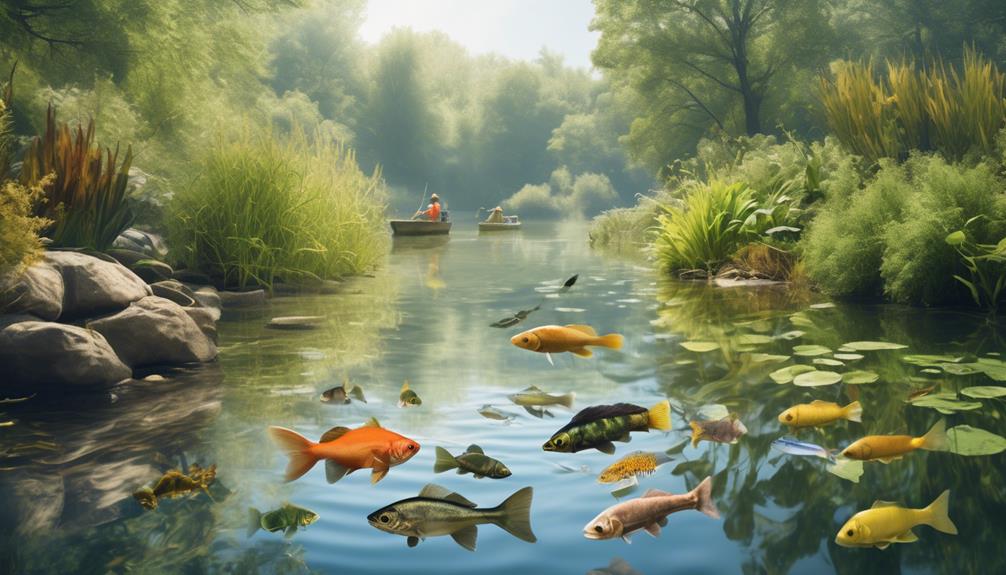
Encouraging habitat restoration efforts can play a vital role in preserving the natural environment for future generations. By supporting habitat restoration, you can actively contribute to the protection and preservation of ecosystems crucial for the sustainability of fish populations and the overall health of aquatic environments.
Here are three key reasons why supporting habitat restoration is essential:
- Habitat Protection: Participating in or supporting habitat restoration projects helps protect critical habitats for fish and other aquatic species. By ensuring the preservation of their natural environments, you directly contribute to the long-term viability of these populations.
- Ecosystem Preservation: Habitat restoration efforts contribute to the overall preservation of ecosystems. Healthy ecosystems are essential for maintaining biodiversity, supporting food webs, and ensuring the balance and resilience of natural environments.
- Sustainable Fisheries: Restoring and protecting habitats is fundamental to maintaining sustainable fisheries. By supporting these efforts, you play a part in ensuring that future generations can continue to enjoy the benefits of abundant and diverse fish populations.
Continuous Learning and Improvement
Engage in ongoing education and refinement to enhance your angling skills and promote ethical catch-and-release practices. Continuous learning and improvement play a crucial role in minimizing the environmental impact of angling and ensuring responsible angling practices.
By staying updated on the latest research and best practices, you can adapt your angling techniques to reduce harm to fish populations and their habitats. Understanding the environmental impact of different angling methods empowers you to make informed decisions that prioritize the well-being of aquatic ecosystems.
Furthermore, ongoing education allows you to stay informed about changes in regulations and guidelines pertaining to catch-and-release angling, ensuring that you're always in compliance with responsible angling practices.
Moreover, continuous improvement in your angling skills can lead to more effective catch-and-release methods, ultimately increasing the survival rates of released fish. The ability to quickly and efficiently release fish back into their natural environment minimizes stress and injury, contributing to the overall health and sustainability of fish populations.
Frequently Asked Questions
How Can Catch-And-Release Angling Help to Maintain Healthy Fish Populations in a Specific Area?
Catch-and-release angling is crucial for maintaining healthy fish populations in specific areas. By releasing fish back into the water, you allow them to grow and reproduce, contributing to sustainable populations. This practice prevents overfishing and helps maintain the balance of the ecosystem.
Catch and release practices also reduce the impact on fish populations, promoting conservation and ensuring that future generations can continue to enjoy angling.
What Are Some Common Misconceptions About Catch-And-Release Angling and How Can They Be Addressed?
Common misconceptions about catch-and-release angling include the belief that fish always die after release and that it doesn't impact their well-being. Addressing these, it's important to highlight the use of proper techniques to minimize stress on the fish, such as avoiding extended fights and handling fish with wet hands.
Educating anglers on these practices can help correct these misconceptions and ensure the well-being of the fish population.
Are There Any Specific Techniques or Gear That Can Help Minimize Stress on the Fish During Catch-And-Release Angling?
To minimize stress on the fish during catch-and-release angling, proper handling is key. Use selective gear like barbless hooks to make releasing easier. Ethical practices such as avoiding excessive fight times and keeping the fish in the water as much as possible also help.
Quickly removing the hook with proper tools and techniques further reduces stress. By applying these methods, you can ensure a safer and more humane catch-and-release experience for the fish.
What Are Some Innovative Ways That Anglers Can Contribute to Habitat Restoration and Conservation Efforts?
You can contribute to habitat restoration and conservation efforts by getting involved in community projects to improve the local environment. Consider joining conservation initiatives and participating in environmental stewardship programs.
You can also take part in habitat restoration efforts by volunteering for clean-up and restoration projects in your area. By actively engaging in these activities, you can make a meaningful impact on the health and sustainability of the natural habitats around you.
How Can Anglers Effectively Educate Others About the Principles of Ethical Angling and the Importance of Catch-And-Release Practices?
To effectively educate others about ethical angling and catch-and-release practices, engage in educational campaigns, outreach events, community engagement, and conservation workshops.
Encourage fellow anglers to prioritize conservation by sharing knowledge, organizing workshops, and participating in outreach events.
Lead by example and showcase the benefits of ethical angling.
Collaborate with local organizations to spread awareness and foster a community dedicated to sustainable and responsible angling practices.
Conclusion
Remember, ethical catch-and-release angling is all about respecting the fish and their environment.
By understanding fish stress, using proper handling techniques, selecting the right gear, and following legal regulations, you can ensure the well-being of the fish population.
Additionally, educating others on ethical angling and supporting habitat restoration are crucial steps in preserving our natural resources.
Keep learning and improving your angling practices to make a positive impact on our aquatic ecosystems.
